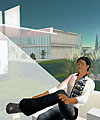Philips Design on experiencing experience design
I hadn’t heard much from it since, until I found a post today by “Centralasian Wise“, one of the members of the Philips Design’s team in Second Life, where he talks about his second SL presentation – I cannot find the first one – that dealt specifically with the experience design process.
During the presentation “Centralasian Wise” also distributed a recent Philips paper about “Experience Evaluation” (pdf, 830 kb, 14 slides) and demonstrated the AMEC research project (AMbient ECologies) that Philips participates in – see summary below.
An earlier “Centralasian Wise” post reports on how Philips Design continues to recruit people for its research projects and creative workshops in Second Life. More information on these, and other research and design activities of the company at the first site of Philips Design in SL, Co-creative Experiences. Using interactive posters on the site, people (or better “SL avatars”) can also join the group of Philips Design Friends, and have a chance to join one of these creative sessions in the future. Both experienced dwellers and total newbies are welcomed.
Ambient Ecologies project
Within the next decade, as digital technologies become increasingly pervasive, we might find ourselves living with almost invisible, intelligent interactive systems – an ‘Ambient Intelligence’ – that will form a part of our everyday existence and ecology. The implications of this development are far reaching for individuals, businesses and communities. Ambient Intelligence could lead to great opportunities. But as with all new technologies, we know that the technology itself is neither good nor bad. It is how we might use it that makes the difference. The main challenge at this moment is to guarantee that the new Ambient Intelligence technologies are appropriate, sustainable and meet people’s individual and social needs.
The AMEC (Ambient Ecologies) project addresses this challenge by defining the architectural framework and developing the methodologies, tools and design methods for people involvement, which will facilitate a user-centred evolution to this new Ambient Intelligent environment.
People, human desire and needs, are the starting point and focus of the AMEC project. The project aims to change the way we conduct our everyday activities by gradually introducing artefacts that are able to perform local computation and to collaborate with each other and interact in a natural and intuitive way with the user. AMEC will achieve this transformation through a series of carefully planned technology innovations, and in close cooperation with people. Their interaction with the new Ambient Intelligence technologies is closely studied and analysed, in order to yield requirements for AMEC developments. These developments are gradually introduced into people’s lives, in carefully controlled research experiments, because acceptance is the major factor for the market success of these new technologies. The work will incorporate and build upon the results of the ITEA projects Beyond and Ambience.




